Choosing a canine companion can be a joyful experience, but for many, the thought of constant shedding and endless vacuuming is a major deterrent. If you’re someone who loves dogs but not the copious amounts of hair they leave behind, or if you live with allergies, finding the right types of small dogs that don’t shed is essential. While no dog is truly 100% “non-shedding” (they all lose some hair, just like humans), certain breeds shed significantly less, making them ideal for cleaner homes and allergy sufferers. These low-shedding dogs often have hair-like coats that grow continuously, rather than fur that sheds in cycles. This guide will introduce you to a wonderful selection of small, minimal-shedding breeds, highlighting their unique personalities and grooming needs to help you find your perfect match. If you’re ready to welcome a furry friend into your home, exploring options like teddy bear puppies for adoption near me can be a great next step after learning about these fantastic breeds.
Affenpinscher
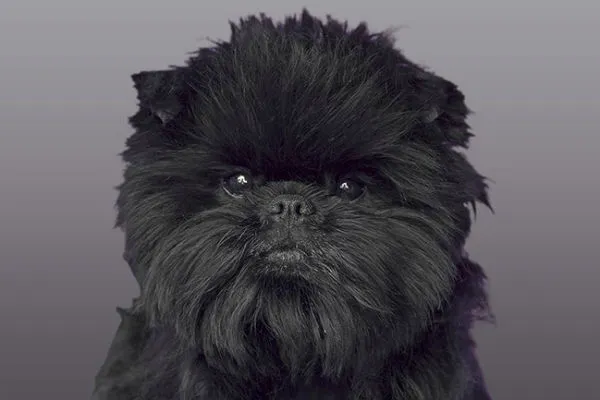 Affenpinscher dog with a curious expressionThe Affenpinscher, whose name translates to “monkey-like terrier,” is as intelligent and amusing as its moniker suggests. Despite their small stature, these Toy breed dogs are remarkably fearless, making excellent little watchdogs. Their wiry coat is a standout feature, shedding very minimally and boasting almost no doggy odor, a huge plus for owners seeking a clean home. Maintaining their shaggy yet neat appearance is straightforward, requiring just a twice-weekly brushing with a slicker brush and comb. Affenpinschers are renowned for their playful demeanor and sense of humor, offering big personality in a compact, low-shedding package.
Affenpinscher dog with a curious expressionThe Affenpinscher, whose name translates to “monkey-like terrier,” is as intelligent and amusing as its moniker suggests. Despite their small stature, these Toy breed dogs are remarkably fearless, making excellent little watchdogs. Their wiry coat is a standout feature, shedding very minimally and boasting almost no doggy odor, a huge plus for owners seeking a clean home. Maintaining their shaggy yet neat appearance is straightforward, requiring just a twice-weekly brushing with a slicker brush and comb. Affenpinschers are renowned for their playful demeanor and sense of humor, offering big personality in a compact, low-shedding package.
Basenji
 Basenji dog standing alert outdoorsFor enthusiasts of hounds who wish to avoid the typical hound odor and heavy shedding, the Basenji offers a unique solution. This breed sheds very minimally, and its sleek, fine coat demands little more than an occasional brushing to keep it pristine. Basenjis are also famously quiet, rarely barking, which makes them an excellent choice for apartment living, provided they receive sufficient daily exercise and opportunities for play. Their clean habits and independent nature make them a fascinating and low-maintenance companion for the right owner.
Basenji dog standing alert outdoorsFor enthusiasts of hounds who wish to avoid the typical hound odor and heavy shedding, the Basenji offers a unique solution. This breed sheds very minimally, and its sleek, fine coat demands little more than an occasional brushing to keep it pristine. Basenjis are also famously quiet, rarely barking, which makes them an excellent choice for apartment living, provided they receive sufficient daily exercise and opportunities for play. Their clean habits and independent nature make them a fascinating and low-maintenance companion for the right owner.
Bichon Frise
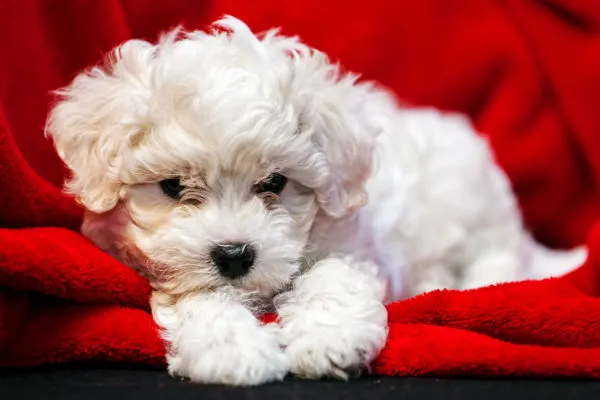 Fluffy white Bichon Frise sitting happilyThe Bichon Frise is genuinely a non-shedding small dog breed, making them one of the most popular choices for individuals with allergies. These cheerful and affectionate dogs are known for their playful spirit, but their “powder-puff” appearance does require commitment. Unlike many breeds, the Bichon Frise’s hair grows continuously, similar to human hair, necessitating frequent professional grooming, regular at-home brushing, and occasional baths to prevent mats and maintain their signature look. Their hypoallergenic qualities and loving nature make the grooming effort well worth it for many families.
Fluffy white Bichon Frise sitting happilyThe Bichon Frise is genuinely a non-shedding small dog breed, making them one of the most popular choices for individuals with allergies. These cheerful and affectionate dogs are known for their playful spirit, but their “powder-puff” appearance does require commitment. Unlike many breeds, the Bichon Frise’s hair grows continuously, similar to human hair, necessitating frequent professional grooming, regular at-home brushing, and occasional baths to prevent mats and maintain their signature look. Their hypoallergenic qualities and loving nature make the grooming effort well worth it for many families.
Bolognese
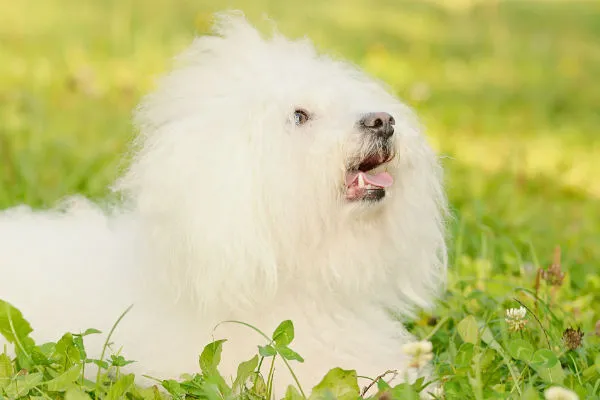 Bolognese dog with a distinctive fluffy white coatSharing traits with the Bichon Frise, the Bolognese possesses a unique fluffy coat composed of hair rather than fur, which means they do not shed. However, this beautiful coat does demand consistent care; dead hair must be brushed out daily to prevent tangles and matting. These lovable lap dogs thrive on companionship and require regular grooming to maintain their pristine appearance. The Bolognese is a quiet and devoted breed, perfect for those seeking an affectionate, low-shedding companion who enjoys a calm indoor lifestyle.
Bolognese dog with a distinctive fluffy white coatSharing traits with the Bichon Frise, the Bolognese possesses a unique fluffy coat composed of hair rather than fur, which means they do not shed. However, this beautiful coat does demand consistent care; dead hair must be brushed out daily to prevent tangles and matting. These lovable lap dogs thrive on companionship and require regular grooming to maintain their pristine appearance. The Bolognese is a quiet and devoted breed, perfect for those seeking an affectionate, low-shedding companion who enjoys a calm indoor lifestyle.
Brussels Griffon
 Brussels Griffon dog looking attentivelyDespite their small size, Brussels Griffons are robust dogs that do not require excessive pampering. This breed comes in both smooth-coated and rough-coated varieties, both of which are minimal shedders and benefit from regular grooming. Their compact size means that their exercise needs are easily met with daily walks and indoor play, making them well-suited for various living situations. Brussels Griffons are known for their loyalty and thrive in homes where they receive plenty of attention, making them wonderful companions for families who are frequently at home.
Brussels Griffon dog looking attentivelyDespite their small size, Brussels Griffons are robust dogs that do not require excessive pampering. This breed comes in both smooth-coated and rough-coated varieties, both of which are minimal shedders and benefit from regular grooming. Their compact size means that their exercise needs are easily met with daily walks and indoor play, making them well-suited for various living situations. Brussels Griffons are known for their loyalty and thrive in homes where they receive plenty of attention, making them wonderful companions for families who are frequently at home.
Chinese Crested
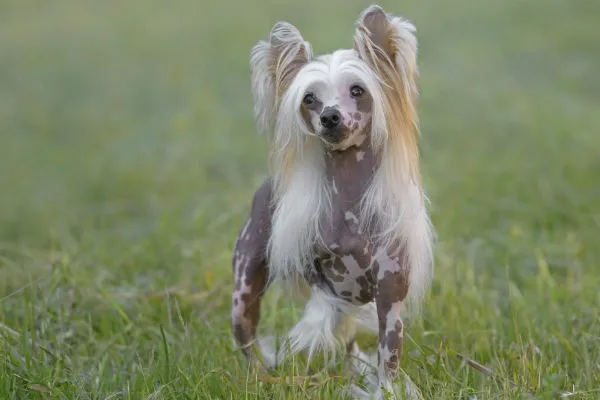 Hairless Chinese Crested dog with hair on head, tail, and feetFor those looking to minimize shedding to an extreme, the Chinese Crested offers a unique solution. This breed comes in two distinct varieties: hairless and powderpuff. The hairless type has soft, silky hair on its head, tail, and feet, with the rest of its body largely bare, while the powderpuff is covered in a soft, fine coat that sheds very minimally. Hairless dogs, in particular, require special skincare, needing protection from sun and cold, and are more susceptible to skin irritations. Despite their unique grooming needs, both varieties are affectionate and playful, making them charming, low-shedding pets.
Hairless Chinese Crested dog with hair on head, tail, and feetFor those looking to minimize shedding to an extreme, the Chinese Crested offers a unique solution. This breed comes in two distinct varieties: hairless and powderpuff. The hairless type has soft, silky hair on its head, tail, and feet, with the rest of its body largely bare, while the powderpuff is covered in a soft, fine coat that sheds very minimally. Hairless dogs, in particular, require special skincare, needing protection from sun and cold, and are more susceptible to skin irritations. Despite their unique grooming needs, both varieties are affectionate and playful, making them charming, low-shedding pets.
Coton De Tulear
 Coton de Tulear dog with a long, fluffy white coatThe Coton de Tulear is celebrated for its distinctive long, fluffy coat, which is considered hypoallergenic and perfect for those with allergies or those who desire a small dog that doesn’t shed. While these dogs are low-shedding, their beautiful coats do require daily grooming to prevent matting and maintain their softness. Known for their lighthearted, gentle, and clown-like personalities, Coton de Tulears are devoted companions that make the grooming effort truly worthwhile. Their cheerful disposition and adaptable nature make them excellent family pets.
Coton de Tulear dog with a long, fluffy white coatThe Coton de Tulear is celebrated for its distinctive long, fluffy coat, which is considered hypoallergenic and perfect for those with allergies or those who desire a small dog that doesn’t shed. While these dogs are low-shedding, their beautiful coats do require daily grooming to prevent matting and maintain their softness. Known for their lighthearted, gentle, and clown-like personalities, Coton de Tulears are devoted companions that make the grooming effort truly worthwhile. Their cheerful disposition and adaptable nature make them excellent family pets.
Havanese
 Havanese dog with long, flowing hairThe national dog of Cuba, the Havanese, brings a patented spunky charm and a non-shedding coat to any home. This means less time spent lint rolling furniture and more time enjoying the playful antics of this affectionate breed. Their long, silky coat requires weekly brushing and regular baths to keep it clean, healthy, and tangle-free. Havanese dogs are intelligent, outgoing, and thrive on being part of family activities, making them highly adaptable and delightful companions for a wide range of owners.
Havanese dog with long, flowing hairThe national dog of Cuba, the Havanese, brings a patented spunky charm and a non-shedding coat to any home. This means less time spent lint rolling furniture and more time enjoying the playful antics of this affectionate breed. Their long, silky coat requires weekly brushing and regular baths to keep it clean, healthy, and tangle-free. Havanese dogs are intelligent, outgoing, and thrive on being part of family activities, making them highly adaptable and delightful companions for a wide range of owners.
Maltese
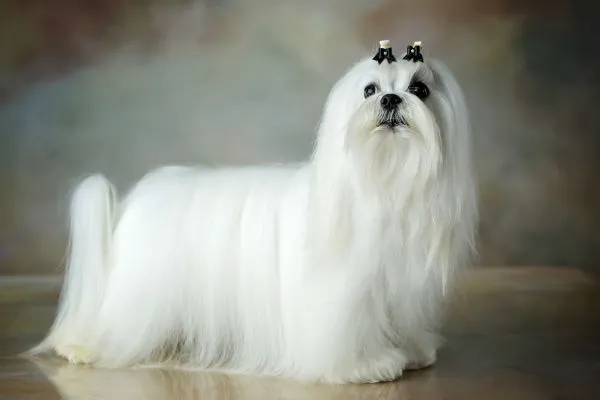 Maltese dog with a long, elegant white coatMaltese dogs have captivated human hearts for over three millennia. This ancient breed from Malta has maintained its elegant appearance, largely due to its long, white coat that sheds very little, making them ideal lap dogs. While their shedding is minimal, their luxurious coats do demand regular daily brushing to prevent mats and an occasional bath to keep their silky hair pristine and bright. Maltese are gentle, charming, and devoted companions, thriving on human attention and making wonderful indoor pets.
Maltese dog with a long, elegant white coatMaltese dogs have captivated human hearts for over three millennia. This ancient breed from Malta has maintained its elegant appearance, largely due to its long, white coat that sheds very little, making them ideal lap dogs. While their shedding is minimal, their luxurious coats do demand regular daily brushing to prevent mats and an occasional bath to keep their silky hair pristine and bright. Maltese are gentle, charming, and devoted companions, thriving on human attention and making wonderful indoor pets.
Lhasa Apso
 Lhasa Apso dog with long hair covering its eyesHailing from the Tibetan mountains, the Lhasa Apso is an excellent companion known for its calm yet playful demeanor. This small dog enjoys brisk walks and is equally content resting on its owner’s lap. Lhasa Apsos do not shed, but their long, flowing double coats require significant maintenance to prevent matting. Many owners opt for a shorter “puppy cut” to simplify daily grooming and brushing, making their care more manageable. These confident and intelligent dogs are known for their strong personalities and loyalty.
Lhasa Apso dog with long hair covering its eyesHailing from the Tibetan mountains, the Lhasa Apso is an excellent companion known for its calm yet playful demeanor. This small dog enjoys brisk walks and is equally content resting on its owner’s lap. Lhasa Apsos do not shed, but their long, flowing double coats require significant maintenance to prevent matting. Many owners opt for a shorter “puppy cut” to simplify daily grooming and brushing, making their care more manageable. These confident and intelligent dogs are known for their strong personalities and loyalty.
Miniature Schnauzer
 Miniature Schnauzer with its characteristic beard and eyebrowsThe Miniature Schnauzer is a smart, trainable, and cheerful Terrier breed that closely resembles its larger Standard Schnauzer cousin. This adaptable breed sheds very little, making them a popular choice for families whether in the city or the countryside, as long as they are close to their human companions. To keep Miniature Schnauzers looking their best, weekly brushing and regular professional grooming are essential to maintain their distinctive wiry coat and traditional schnauzer cut. Their lively spirit and alert nature make them excellent watchdogs and engaging family members.
Miniature Schnauzer with its characteristic beard and eyebrowsThe Miniature Schnauzer is a smart, trainable, and cheerful Terrier breed that closely resembles its larger Standard Schnauzer cousin. This adaptable breed sheds very little, making them a popular choice for families whether in the city or the countryside, as long as they are close to their human companions. To keep Miniature Schnauzers looking their best, weekly brushing and regular professional grooming are essential to maintain their distinctive wiry coat and traditional schnauzer cut. Their lively spirit and alert nature make them excellent watchdogs and engaging family members.
Poodle
 Poodle with a stylish haircut, looking regalWhen considering small dogs that don’t shed, Poodles are often the first breed that comes to mind, and for good reason. Poodles, in their Miniature and Toy varieties, are non-shedding and hypoallergenic, offering these desirable traits in intelligent and petite packages. All Poodles are highly intelligent, making them exceptionally trainable and keen participants in various dog sports. Their curly, dense coats do require regular professional grooming to prevent matting and maintain their iconic appearance, but their elegant demeanor and active nature make them incredibly rewarding companions.
Poodle with a stylish haircut, looking regalWhen considering small dogs that don’t shed, Poodles are often the first breed that comes to mind, and for good reason. Poodles, in their Miniature and Toy varieties, are non-shedding and hypoallergenic, offering these desirable traits in intelligent and petite packages. All Poodles are highly intelligent, making them exceptionally trainable and keen participants in various dog sports. Their curly, dense coats do require regular professional grooming to prevent matting and maintain their iconic appearance, but their elegant demeanor and active nature make them incredibly rewarding companions.
Scottish Terrier
 Scottish Terrier with its distinctive wiry coatThe Scottish Terrier, affectionately known as a Scottie, is a Terrier breed celebrated for its boldness, confidence, and surprisingly big personality in a small body. Their wiry, weather-resistant double coat sheds very minimally, making them a great choice for those seeking a low-shedding dog. However, Scotties do require regular brushing, professional grooming, and occasional hand-stripping to keep their coats healthy and maintain their distinctive silhouette. These clever and independent dogs possess strong prey drives, so owners should be mindful when they are around smaller animals.
Scottish Terrier with its distinctive wiry coatThe Scottish Terrier, affectionately known as a Scottie, is a Terrier breed celebrated for its boldness, confidence, and surprisingly big personality in a small body. Their wiry, weather-resistant double coat sheds very minimally, making them a great choice for those seeking a low-shedding dog. However, Scotties do require regular brushing, professional grooming, and occasional hand-stripping to keep their coats healthy and maintain their distinctive silhouette. These clever and independent dogs possess strong prey drives, so owners should be mindful when they are around smaller animals.
Shih Tzu
 Shih Tzu with long, luxurious hair and a proud stanceWith a long and illustrious pedigree, the Shih Tzu was once the favored house pet of the Tang Dynasty emperors. These “little lion dogs” come in a variety of colors and patterns. Their long, silky hair is very low-shedding and looks exceptionally regal when brushed out daily, befitting their royal ancestry. Despite their regal carriage, often described as arrogant due to their proudly held heads and curling tails, Shih Tzus are sturdy, lively, and were bred purely for companionship. Their gentle, trusting nature makes them exceptional and devoted house pets.
Shih Tzu with long, luxurious hair and a proud stanceWith a long and illustrious pedigree, the Shih Tzu was once the favored house pet of the Tang Dynasty emperors. These “little lion dogs” come in a variety of colors and patterns. Their long, silky hair is very low-shedding and looks exceptionally regal when brushed out daily, befitting their royal ancestry. Despite their regal carriage, often described as arrogant due to their proudly held heads and curling tails, Shih Tzus are sturdy, lively, and were bred purely for companionship. Their gentle, trusting nature makes them exceptional and devoted house pets.
West Highland White Terrier
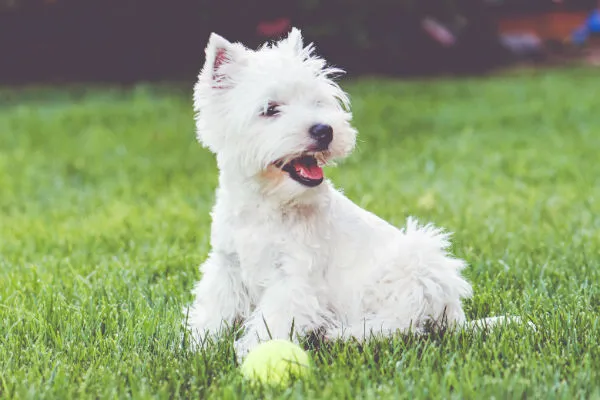 West Highland White Terrier (Westie) sitting attentivelyThe coarse, crisp white coat of the West Highland White Terrier, fondly called a Westie by enthusiasts, sheds very little, making them another excellent choice for those sensitive to dog hair. These sturdy little dogs are intelligent, loyal, happy, and immensely entertaining. Westies are curious dogs with moderate energy levels and an independent streak common among all Terriers, which can sometimes make training a delightful challenge. Their compact size and robust health contribute to their popularity as family companions.
West Highland White Terrier (Westie) sitting attentivelyThe coarse, crisp white coat of the West Highland White Terrier, fondly called a Westie by enthusiasts, sheds very little, making them another excellent choice for those sensitive to dog hair. These sturdy little dogs are intelligent, loyal, happy, and immensely entertaining. Westies are curious dogs with moderate energy levels and an independent streak common among all Terriers, which can sometimes make training a delightful challenge. Their compact size and robust health contribute to their popularity as family companions.
Xoloitzcuintli
 Hairless Xoloitzcuintli dog with alert expressionAlso known as the Mexican Hairless, the Xoloitzcuintli is an ancient and rare breed that can be found in both hairless and coated varieties. The hairless type typically retains a small amount of hair on its head, while the coated variety sports a very short, fine coat that sheds minimally. As with any hairless breed, Xolos require extra attention to their skin, needing protection from the elements. Xolos are known for being attentive watchdogs and affectionate companions. While they enjoy physical activities, they are equally content with a tranquil presence around the home, making them versatile pets.
Hairless Xoloitzcuintli dog with alert expressionAlso known as the Mexican Hairless, the Xoloitzcuintli is an ancient and rare breed that can be found in both hairless and coated varieties. The hairless type typically retains a small amount of hair on its head, while the coated variety sports a very short, fine coat that sheds minimally. As with any hairless breed, Xolos require extra attention to their skin, needing protection from the elements. Xolos are known for being attentive watchdogs and affectionate companions. While they enjoy physical activities, they are equally content with a tranquil presence around the home, making them versatile pets.
Yorkshire Terrier
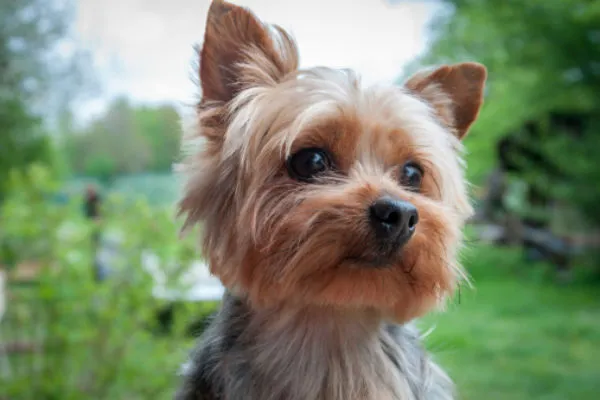 Yorkshire Terrier (Yorkie) with silky hair and a curious lookSprightly, tomboyish, and incredibly affectionate, the Yorkshire Terrier, or Yorkie, is a Toy breed brimming with personality. These spunky lap dogs are among the most popular breeds globally, and for good reason. Yorkshire Terriers do not shed, and their long, silky coats are stunning when brushed out daily, a task made easy by their small size. Don’t let their regal appearance fool you—Yorkies have working-class roots, originally hunting rats in English clothing mills. Today, they are just as happy snuggling on their owner’s lap as they once were chasing rodents, offering a fearless and loving companionship.
Yorkshire Terrier (Yorkie) with silky hair and a curious lookSprightly, tomboyish, and incredibly affectionate, the Yorkshire Terrier, or Yorkie, is a Toy breed brimming with personality. These spunky lap dogs are among the most popular breeds globally, and for good reason. Yorkshire Terriers do not shed, and their long, silky coats are stunning when brushed out daily, a task made easy by their small size. Don’t let their regal appearance fool you—Yorkies have working-class roots, originally hunting rats in English clothing mills. Today, they are just as happy snuggling on their owner’s lap as they once were chasing rodents, offering a fearless and loving companionship.
Other Small Low-Shedding Terrier Breeds
 Border Terrier dog with a wiry coatThe Terrier group is a treasure trove of small dogs that either don’t shed or shed very minimally. Breeds with wiry and coarse coats, in particular, tend to shed less than those with softer fur, making Terriers an excellent category for individuals seeking a low-shedding companion. Beyond the specific breeds highlighted above, many other Terriers, such as the Border Terrier, Lakeland Terrier, and Norfolk Terrier, also boast minimal shedding coats, though their specific grooming needs and temperaments vary. It’s always beneficial to research individual breeds within this group to find one that perfectly aligns with your lifestyle.
Border Terrier dog with a wiry coatThe Terrier group is a treasure trove of small dogs that either don’t shed or shed very minimally. Breeds with wiry and coarse coats, in particular, tend to shed less than those with softer fur, making Terriers an excellent category for individuals seeking a low-shedding companion. Beyond the specific breeds highlighted above, many other Terriers, such as the Border Terrier, Lakeland Terrier, and Norfolk Terrier, also boast minimal shedding coats, though their specific grooming needs and temperaments vary. It’s always beneficial to research individual breeds within this group to find one that perfectly aligns with your lifestyle.
Conclusion
Finding the right small dog that doesn’t shed can significantly enhance your life, offering companionship without the constant cleanup or allergy concerns. However, remember that “non-shedding” doesn’t equate to “no maintenance.” Every dog, regardless of its shedding habits, requires dedication to grooming, proper nutrition, and regular veterinary care to ensure a happy, healthy life. Before bringing a new pet home, take the time to thoroughly research various breeds, understand their unique needs, and consider how they fit into your lifestyle. Always seek out reputable breeders or adoption agencies to ensure you welcome a healthy, well-socialized puppy into your family. Your perfect low-shedding companion is out there, waiting to bring joy and affection into your home.
